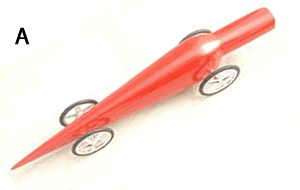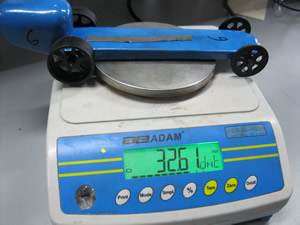CO2 racers - energy and forces
worksheet

Investigate the following questions. Research might be needed.
1) One of the forces acting on the racers, pictured on the right, is gravity, what are three other forces ?
a)
b)
c)

2) Explain how each force acts on the racer. Gravity is given as an example below.
a) Gravity acts to pull the racer down on the track.
b)
c)
d)
3) Explain how each of the forces mentioned in 2) above are generated.
a)
b)
c)
d)
4) The raw materials to make a racer are pictured on the right and so is the final product labelled "A". Students are encouraged to spend time on shaping, painting and polishing their racer. This will make the racer travel faster.
a) What force are we aiming to maximise or minimise by shaping and polishing the surface?

6) Include a picture of your racer.
a)
Discuss the features of your design that will maximise the speed of the racer.
b) Did the racer perform as you expected? What changes could be made to the design to achieve a greater speed?
7) Research the following. You may find this link helpful
a) What is potential energy?
b) Does your racer have potential energy as it sits at the starting line? Explain.
c) What is kinetic energy?
d) Does your racer have kinetic energy as it travels down the track? Explain
e) What does the law of conservation of energy state?
f) As the racer slows down what is happening to the kinetic energy?
g) What is the kinetic energy being converted into as the racer slows down?
8) The formula for kinetic energy is (0.5mv2) where m is the mass, in kilograms, of the racer and v is its speed in m/s. The energy is given in Joules.
Weigh your racer and record its mass in kilograms. The winning model is shown on the right being weighed on an electroinc balance. Its mass is 32.61 grams or 0.03261 kg and it covered the 30.0 metre course in 0.88 seconds.
a) The following are what you need to know in order to calculate the kinetic energy of your racer?
i) Its mass in kilograms
ii) Its average speed over the 30.0 metre course?
b) How many Joules of kinetic energy did your racer have assuming that it did not change mass during the race?
c) If your racer was not the winning racer for this year, calculate the winners kinetic energy?
d) Compare your design with the winning design. What differences do you notice?

9) Consider the picture of the racers on the right.
a) Which one of the four forces is maximised as the racer accelerates down the track?
b) Two racers of equal mass are pictured on the right as they just come off the starting line. There is an obvious difference in the speed of each racer. Give a possible explanation of how this difference may come about considering the racers have just started to accelerate and their speed, at this point, is fairly slow.
